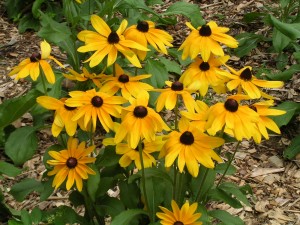![By Bob Peterson from North Palm Beach, Florida, Planet Earth! [CC BY-SA 2.0 (http://creativecommons.org/licenses/by-sa/2.0)], via Wikimedia Commons](https://blogs.ifas.ufl.edu/pinellasco/files/2015/05/Metallic_Green_Bee_Augochloropsis_sp._on_Coreopsis_7173773106-300x300.jpg) Do you long to see more birds and butterflies flying about your garden? Do you want to help Florida’s wild critters survive? Are you tired of spending money and time watering, fertilizing, pruning and mowing your landscape? By knowing and understanding your yard’s native ecosystem you can choose plants that are almost maintenance-free while also attracting birds, butterflies and other pollinators.
Do you long to see more birds and butterflies flying about your garden? Do you want to help Florida’s wild critters survive? Are you tired of spending money and time watering, fertilizing, pruning and mowing your landscape? By knowing and understanding your yard’s native ecosystem you can choose plants that are almost maintenance-free while also attracting birds, butterflies and other pollinators.
Florida is the third most diverse state in the U.S., with 69 distinct ecosystems including forests, prairies, swamps, marshes, bogs, streams, ponds, estuaries, sandhills, flatwoods and sand scrubs. Ecosystems are distinct groups of populations of living things that are naturally linked with each other and occur on the landscape wherever certain physical conditions exist. Ecosystems are complex, intricate, ancient and many times support distinct and rare species. The more we learn about them, the more we value their uniqueness, which can bring great pleasure and wonder into our lives.
Unfortunately, many of these ecosystems have been drastically reduced in size or are in dire need of renewal.
Today in Florida more than 130 animals are listed as endangered, threatened or of special concern. The good news is that concerned and caring Florida residents have the power to help bring back many of the plant communities necessary to support our vanishing species.
Just by knowing what type of habitat our yards would normally support, we can start to get Florida back to being Florida, and hopefully bring back many of the species that are now endangered or threatened. In Pinellas County we have, or had, four major ecosystems: coastal strand or upland, sandhill, flatwoods and salt marsh.
The far west side of the county is a coastal strand which occurs parallel and next to coastal beaches. These are the dunes, an extremely harsh environment for plants. In Florida, only a few patchy bits and pieces remain.
Plants in the coastal strand must be tolerant of salt, wind and blowing sand and most plants and shrubs are stunted and “pruned’ by these actions. Plants which characterize this community include beach panic grass, sea oats, blanket flower, beach sunflower, sea purslane, beach morning glory, sea grape, cocoplum, inkberry, necklace pod, saw-palmetto, bay cedar, live oak and cabbage palm. These plants support many threatened shorebirds (including plovers), terns (including least and roseate species), gulls, endangered beach mice, endangered sea turtles, lizards, snakes, gopher tortoise, the threatened scrub jay and the threatened kestrel.
The coastal strand also reduces the impact of storm surge from hurricanes by reducing wave action, and thus helps to protect Florida’s more interior areas.
The sandhill ecosystem is inland of the coastal strand. This area is high, very dry, low in nutrients and has loose, well-drained soils that allow for rapid aquifer recharge. Grasses that do well include Elliott lovegrass, Lopsided indiangrass, wiregrass and broomsedge bluestem. Small plants such as butterfly weed, day flower, tickseed, blanket flower, beebalm, black-eyed Susan, blue-eyed grass, and spiderwort also thrive here. Peppervine, butterfly pea, passion flower, blackberry and wild grape are vines for this habitat. Shrubs include pawpaw, American beautyberry, coontie, coralbean, yaupon holly, firebush, and saw palmetto. Many of the small oaks including Chapman, bluejack, turkey and myrtle oak live here, with sand, slash and longleaf pine as the large dominating trees, along with American holly and southern red cedar.
Most sandhill habitats have been cleared and developed, leaving only three percent of this ecosystem intact nationwide. The southeastern American kestrel, red-cockaded woodpecker, blue-tailed mole skink, eastern indigo snake, Gopher tortoise, Florida mouse and short-tailed snake are all in jeopardy of extinction because of this loss of habitat.
Florida’s most widespread ecosystem, and a large part of Pinellas County, is the flatwoods. They occur on level land with very gradual movement of water to swamps, ponds and marshes. During the rainy season conditions are very wet, with the water table on or near the surface. The soils are usually acidic. Plants here need to be able to tolerate periods of saturated soil and flooding, as well as very dry soil. Annuals and perennials include milkweed (use native only), mistflower, tickseed, spider lily, blue flag iris, blazing star, pine lily, coneflower, tropical sage, blue-eyed grass, goldenrod, spiderwort, cinnamon fern, royal fern, bracken fern and chain fern. Many vines live here including peppervine, trumpet creeper, butterfly pea, yellow jessamine, sensitive vine, passion flower, blackberry and wild grape. Shrubs to plant are yaupon holly, gallbery, firebush, staggerbush, fetterbush, southern was myrtle, saw palmetto, and elderberry. Common persimmon, dahoon holly, American holly, cabbage palm, live oak and many pines including slash, longleaf, pond and loblolly can be planted.
Wildlife linked with a flatwoods community include gray squirrels, gray fox, white-tailed deer, Bachman’s sparrows and sandhill cranes.
A small portion of Pinellas was once salt marsh. This is another harsh environment for plants, with conditions varying between extremes of salt and fresh water, wet and dry, hot and cold. Only a few plants can stand these extremes, including sand cordgrass, needle rush, saltwort, bushy seaside oxeye, saltgrass and saltwort. Animals found in this community include the fiddler crab, periwinkle snail, killifishes and other minnows, salt marsh snake, green treefrog, southern leopard frog and three bird species – the clapper rail, marsh wren and seaside sparrow (which can only live in this habitat).
We may not be able to fully bring back these plant and animal communities in our small yards, but we can certainly help, especially if we get our neighbors to do the same. Look around your yard. I’m sure you will find mostly exotic (non-native) plants from other parts of the world that are not part of this ecosystem and do little to nothing to support its unique community of plants and animals. Many ornamental plants from earlier days have turned into invasive species and can be found on the Florida Exotic Pest Plant Council website. Start replacing these exotics or begin adding to your yard native species that will help to restore lost habitat. Native plants in the right place are low maintenance, usually don’t require lots of resources to grow and are good for the environment.
There are many resources to help you find plants for each of these ecosystems and to learn more about our incredibly diverse and beautiful Florida. One excellent way is to join like-minded folks in your local Native Plant Society. In addition, there are some very good, Florida-specific books such as: Priceless Florida – Natural Ecosystems and Native Species by Ellie Whitney, D. Bruce Means, and Anne Rudloe; Landscaping for Florida’s Wildlife – Re-creating Native Ecosystems in Your Yard by Joe Schaefer and George Tanner; and Florida’s Best Native Landscape Plants – 200 Readily Available Species for Homeowners and Professionals by Gil Nelson.
 0
0



